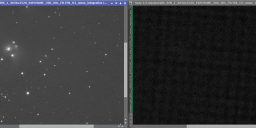Howdy, Stranger!
It looks like you're new here. If you want to get involved, click one of these buttons!
In this Discussion
Low rejection pattern
I'm getting a checkerboard pattern on the low rejection image of a master light. The master light is an integration of three hours of O3 data taken with a 1600MM pro camera. I don't get this pattern in any other lights, even those taken through an Ha filter. I wouldn't be troubled by it but the master light has a faint, fine, mottling that looks sort of wind-swept.
The guiding program dithered between each frame.
Any suggestions on where to start to investigate the cause of the pattern?


Screenshot (69).png
1605 x 614 - 895K

Comments
masterLight_BIN_1_4656x3520_EXPOSURE_300_00s_FILTER_O3_mono_rejection_low
K
count (%) 100.00000
count (px) 16389120
mean 1742.093
median 1008.230
avgDev 1784.869
MAD 1494.802
minimum 0.000
maximum 61502.077